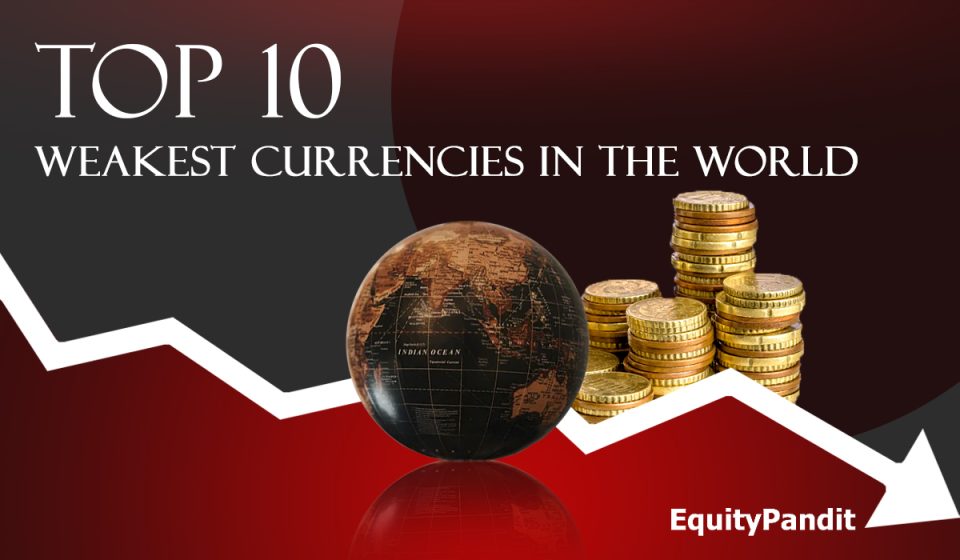While strong currencies often grab attention, the weakest ones reveal deeper stories about global economic health. Currency value is seen as a symbol of a country’s economic strength and its integration with global trade. However, not all currencies manage to hold their ground, with some struggling due to weak economies, political instability, and external pressures.
Here Are The Top 10 Weakest Currencies:
| Currency | Symbol | Value In 1 INR | Value in 1 USD |
| Iranian Rial | IRR | 497.90 IRR | 42,051.5 IRR |
| Vietnamese Dong | VND | 299.94 VND | 25,347.9 VND |
| Sierra Leonean Leone | SLL | 269.14 SLL | 22,748.6 SLL |
| Laotian Kip | LAK | 259.44 LAK | 21,943.6 LAK |
| Indonesian Rupiah | IDR | 187.67 IDR | 15,847.8 IDR |
| Uzbekistani Som | UZS | 152.08 UZS | 12,868.5 UZS |
| Guinean Franc | GNF | 101.89 GNF | 8,615.8 GNF |
| Paraguayan Guarani | PYG | 92.18 PYG | 7,798.5 PYG |
| Cambodian Riel | KHR | 47.62 KHR | 4,025.09 KHR |
| Ugandan Shilling | UGX | 43.67 UGX | 3,690.7 UGX |
1. Iranian Rial (IRR):
The Iranian Rial is considered the least valuable currency globally, influenced by factors such as political instability, the Iran-Iraq war, and the nation’s nuclear program.
2. Vietnamese Dong (VND):
The Vietnamese Dong is devalued severely with the centralised transformation of the country into a market economy since the transition still has a way to go.
3. Sierra Leonean Leone (SLL):
Sierra Leonean Leone has lost enormous value due to poverty and corruption, the civil war in the country, as well as the Ebola break-out in 2014. Economic failures in this nation have significantly weakened their currency.
4. Laotian Kip (LAK):
The Laotian Kip has kept low since its inception back in 1952. Given that the economy of Laos is small and heavily dependent on foreign aid, there exists projects that may trigger development, such as the just-built railway to China.
5. Indonesian Rupiah (IDR):
The Indonesian Rupiah has been a weak currency for the past 7 years because of commodity prices that are falling, the lack of foreign currency, and the reduction in foreign exchange reserves. Indonesia’s economy is mostly based on natural resources, and with such a large percentage of sovereign bonds held by foreign investors, this makes the value of the currency go even lower.
6. Uzbekistani Som (UZS):
Uzbekistan is moving from a controlled governmental economy to a market-oriented one, but political issues, inefficiencies keep the som weak. The country has a weak economy that’s been worsened by the pandemic, which in turn showed signs of recovery during late 2022; however, industrial output shows a decline that may unsettle the currency in the short term.
7. Guinean Franc (GNF):
The Guinean Franc remains weak due to years of political issues, corruption, and slow growth. Despite having valuable natural resources, Guinea has struggled to develop other industries, keeping its currency low. Ongoing government problems continue to limit progress.
8. Paraguayan Guarani (PYG):
The Paraguayan Guarani is weak due to high inflation, poverty, and unemployment. Despite improvements in farming, the economy struggles, with corruption and a past economic collapse further hurting the currency.
9. Cambodian Riel (KHR):
This currency is weak because the usage of the US dollar has been high, after political instability in the 80s and 90s, making the Riel less powerful. The National Bank of Cambodia increased circulation of the Riel but the economy still uses US dollars mostly in cities and in tourism.
10. Ugandan Shilling (UGX):
The Ugandan Shilling is one of the weakest currencies, mainly brought about by the damages due to Idi Amin’s rule in the 1970s and some disastrous economic policies. The currency gained some improvements, but it still can’t stand the corruption and poor leadership that plagues this country.
Key Factors Affecting Currency Exchange Rates
- Current Account Deficits: A deficit lowers currency value as demand for foreign currencies increases.
- Economic Performance: Strong economies and political stability boost demand for the local currency.
- Government Debt: High debt can scare off investors, weakening the currency.
- Inflation and Interest Rates: High inflation leads to higher interest rates, attracting investment and strengthening the currency.
- Recession: Economic slowdown and low interest rates decrease demand for the currency.
- Speculation: Currency value can rise or fall based on investor expectations.
- Terms of Trade: Better export prices than imports increase currency demand and value.
Some Frequently Asked Questions (FAQs)
Which is the weakest currency in the world?
The Iranian Rial (IRR) is the weakest, with 1 Indian Rupee equalling 497.90 Iranian Rials, owing to political instability, the Iran-Iraq war, and the country’s nuclear program.
Why is the Vietnamese Dong so weak?
The Vietnamese Dong (VND) is still very weak because of the fact that they are still transiting from a centralised economy to a market economy which has drastically devalued itself.
How does government debt affect currency value?
Government debt has a tendency to scare off investors from using the currency, thereby reducing the local currency’s demand and weakening.
How does inflation and interest rate affect currency value?
High inflation is associated with high-interest rates, which attract investors in search of greater returns and thus strengthens the currency.
Unlock profitable opportunities every day! Unicorn Signals provides actionable intraday trading signals for stocks and futures. Don’t miss out – download Unicorn Signals and start winning now!
 Live
Live

